Films in the PFF Award 2023 - 2/2
Seconde part of Films in the PFF Award 2023 - 2/2
(in order of film length)
See You Next Week... by HYNES Mariko (36 min.) 『また来週』
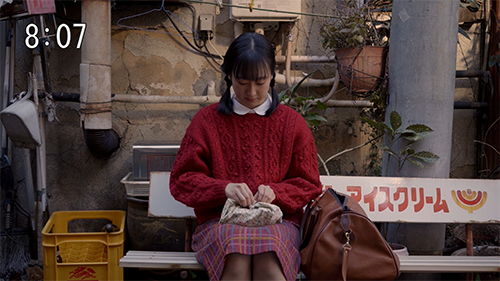
The life of a girl in high school begins to mirror the lead character in the morning TV drama she’s obsessed with.
In post-WWII Japan, a young girl (MORIKAWA Chihiro) tells her conservative parents she wants to go to Osaka to fulfill her dream of becoming an actress. We realize it’s a morning TV drama playing out, watched by high school student Asako (also played by MORIKAWA Chihiro). Asako’s morning TV ritual makes her late for school every day, angering her home room teacher and exasperating her hard-working single mother. Her guidance counselor is sympathetic, and Asako confides in her that she has similar aspirations of becoming an actress. Asako also develops a friendship with her cultured classmate Yuka, who plays the violin beautifully. Asako’s other classmates are not so kind, laughing at Asako for the similarity of her plight to the drama’s protagonist. All of the characters gradually spill over into both worlds, with fiction and reality seemingly influencing each other as they converge. How will the story end for both Asakos?
■Director HYNES Mariko perfectly captures the tone and style of Japan’s beloved NHK morning dramas and intercuts fiction and reality until they blend seamlessly. This entertaining film brimming with creativity is also a sharp commentary on the ideals fiction can drive us to live up to.
Half Timeby Zhang Yaoyuan (30 min.)『ハーフタイム』
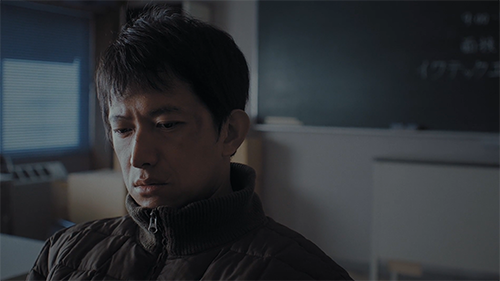
A Chinese laborer working in Japan tries his best to play by the rules to support his family back home, but faces adversity at every turn.
Japan-based Chinese laborer Qingyang struggles to explain himself in Japanese at his latest job interview, but fails. He’s then berated by his local Chinese employment coordinator. This only adds to his hardship of unpaid wages due to his previous vegetable factory’s closure in Okinawa. He drinks with his dorm mate, who decides to go on the run and find work illegally. “If you want money, forget about saving face,” he says. While Qingyang is desperate to support his wife and son back home, he doesn’t want to break the rules as a visa overstayer. Unfortunately, his colleague’s actions affect his situation negatively and his wife threatens to leave him. A non-profit labor lawyer convinces Qingyang to trust his efforts to protect his rights. Qingyang steels himself for another interview, but there’s a shocking turn of events...
■Director ZHANG Yaoyuan depicts the plight of Japan-based laborers who hail from his own region of Northeastern China, which many fled due to the government’s retrenchment policies. In its 34 minutes, the film captures the raw reality of the exploitation many Asian laborers face under Japan’s technical intern training program, sometimes at the hands of their own compatriots.
On a Long Summer Dayby Liu Ge (28 min.) 『ただいまはいまだ』
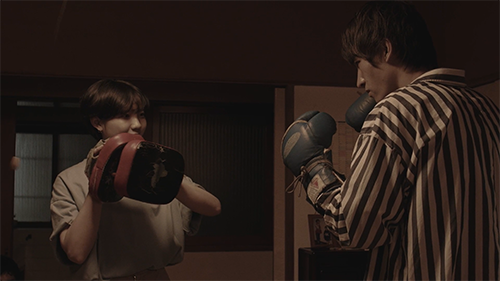
Two Chinese residents living in Japan reunite during the border restrictions of the pandemic and bond over their life decisions with a Japanese friend.
Chinese exchange student Li visits his buddy Taro in the suburbs to find the apartment of estranged childhood friend Gao (Li’s and Gao’s fathers are old friends). Gao’s not home but contacts Li soon after and meets them at the park. Li implores Gao to call his father in China, but Gao refuses to leave Japan as he wouldn’t be able to return under the current pandemic border conditions. Li feels no stress over staying put –– he enjoys Tokyo. When Taro invites them over for dinner, Gao initially refuses but later joins. Along with Taro’s sister Asuka, the four bond over talking about their lives and complicated paternal relationships. Taro reveals he failed to become a pro boxer like his dad. After dinner and drinks, Taro gets the old boxing gear out and both Gao and Li try punching for the first time. It becomes a release. The morning after, personal decisions are made.
■Director LIU Ge portrays friendship between Japanese and non-Japanese residents in a refreshingly matter-of-fact way, without platitudes or grand statements on differences. He draws naturalistic performances from his cast and accomplishes layered storytelling that belies the film’s running time. A lightning-backed conversation on the balcony is impressive.
Flip-Up Tonicby WAKUI Ryo (26 min.)『Flip-Up Tonic』
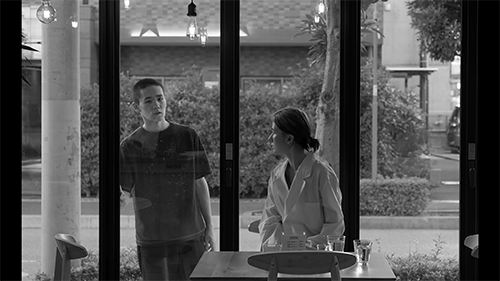
A university student applies for a trial session with a humanoid robot developed on campus and becomes shocked when it goes missing.
First year university student Tarano signs up for a paid session where he will experience time spent in the company of a humanoid robot developed in the science department. After signing a non-disclosure agreement and handing over his smart phone, Tarano, the android’s creator Dr. Sinntow, and the android, which goes by the moniker of LEACHAR (“Laboratory Engineered Astonishingly Capable Human Android Robot”) head to a local café for a chat. Tarano is stunned by the perfectly lifelike appearance of the robot. After a slip-up with a glass of water forces Tarano to change shirts, he’s shocked to find LEACHAR has left the scene and heads back to the campus with Sinntow. He’s paid his participation fee and is none the wiser to the surprising truth of the experiment...
■With its crisp black-and-white photography and non-linear storytelling, director WAKUI Ryo aimed to pay homage to both classic cinema and famous movies with time-jumping narratives. The order the chapters play out creates tension, embellished by a clever twist.
Sad Colorby TAKAHASHI Eiichi (24 min.)『サッドカラー』

When a woman is diagnosed as lacking the ability to feel sadness, her husband confines her to their apartment until she recovers, but the situation devolves into madness.
Matome is unsettled by his wife Mia’s recently happy state. He urges her to get examined by a medical specialist, who analyzes Mia’s tears and determines that she’s unable to feel the emotion of sadness. She denies the result, but her husband is shattered by the truth. Believing that a human missing this emotion is a danger to others, Matome confines Mia to their apartment and attempts help her recover with peculiar notions of things that make people sad (such as having to eat a slice of burnt toast). After Mia’s initial anger passes, she begins to question whether sadness is a necessary emotion at all. In a last bid effort to force Mia’s sadness to return Matome makes the ultimate sacrifice, but how will it affect Mia’s existence?
■Influenced by the writings of philosopher Benedictus de Spinoza, filmmaker TAKAHASHI Eiichi skillfully employs geometric framing and chiaroscuro lighting to depict a semi-dystopian world where emotions can be scientifically analyzed with mathematical precision.
Time of Absence by KAWAGUCHI Junya (21 min.)『不在の出来事』

A man carries out his daily chores before leaving the house, after which the space seems to come alive with a little help from nature.
A young man living alone wakes up and goes about his daily routine. He gets dressed, hangs the laundry out on the veranda, and washes up the sink full of dishes. He gets a call from his girlfriend and agrees to meet up. After he leaves the apartment, nature takes over. With charming piano accompaniment, the wind choreographs a beautiful dance performed by the curtains, the socks hanging outside, and stray tufts of cotton. Scattered shopping receipts traverse the floor like migrating fish. Doors open and close by invisible hands. Rivulets of water drizzle down fixtures like natural springs. Condensation forms on a wall like a forehead perspiring on a hot summer day. Even the setting sun is alive within the door’s peephole, until...
■Director KAWAGUCHI Junya (who also shoots, edits, and stars in the film) turns an average Tokyo apartment into a stage for nature to put on a spectacular show. The director has a keen eye for beautiful details that most of us overlook in our busy lives.
Chotto Hakuneby OHNO Senari (20 min.)『ちょっと吐くね』
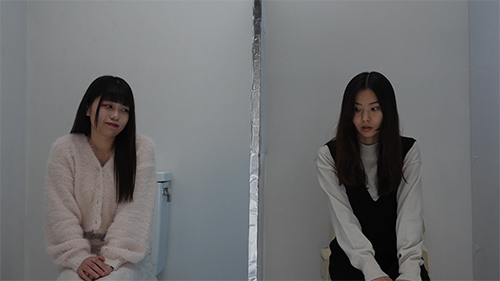
Two young women at university bond over their psychological need to secretly throw up, and learn about themselves in the process.
At the university dining hall, Yuzusa asks her boyfriend for a bite of curry but immediately goes to throw up. She has been hiding her eating disorder. On another day at the same toilet, Yuzusa overhears a girl vomiting in the adjacent stall and asks if she’s okay. Art student Shizuha is also afflicted and the pair strike up an anonymous relationship over the partition in the little-used washroom, agreeing to meet regularly. Yuzusa confesses that she wants to become as cute as Elsa Schiaparelli’s “shocking pink,” while Shizuha is relieved that someone like Yuzusa also pukes. In the meantime, Yuzusa’s boyfriend struggles to accept her eating habits and disagrees that it will help her overcome her self image issues. After the pair of girls finally come face to face, they realize their feelings about throwing up differ...
■Director OHNO Senari discovered a considerable number of her friends had experienced eating disorders, and conceived of this film as a way to work through her feelings of undue attention and evaluation toward her own abnormalities. The constructed set of the two toilet stalls and metaphorical visual of paint-pouring artwork are astute creative choices.
Kokorozashi to Tokyo by SUZUKI Rintaro (10 min.) 『こころざしと東京の街』
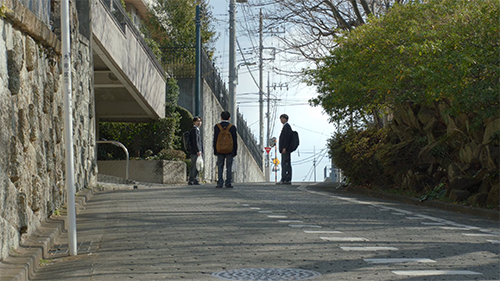
The day arrives for two high school classmates to declare their future plans. One of them has precise goals while the other is undecided. When the chance to have some innocent fun arises, they reach a crossroads.
Sato and Kanemoto are two second-year high school classmates coming to the end of their third term, and today is the deadline to submit their career aspiration surveys. Kanemoto is ahead of the game, with a highly practical approach to his university and career pursuits. Sato is the opposite – ambivalent about what direction he wants to take in life. He asks Kanemoto to wait for him so they can leave together. By the end of the school day, Sato fortunately receives a one-day extension to research his options and make his final submission. On the walk home with Kanemoto, they run into two other classmates who invite them out to a bout of karaoke. Kanemoto remains diligent about his studies while Sato gives in to temptation, despite Kanemoto’s muted disappointment. Along the way Sato changes his mind, but is it too late?
■Director SUZUKI Rintaro skillfully uses mundane locations – desks, residential streets, and train platforms – as a microcosm to stage the paths, diversions, and disorientation in the two boys’ lives.
Parking Area by MASUYAMA Toru (9 min.)『Parking Area』

A woman stops at a highway rest area and enters a portal to another world, before getting back on the road to an even more epic destination.
A Mazda travels smoothly along the highway. We float inside the car through the rear window and find a woman asleep in the seemingly self-driving vehicle. She awakens and we are briefly inside the world of her eye. At dusk, she stops at a highway rest area and uses a massive restroom with infinite sinks to wash her hands. She explores the structure and crosses a walkway into a futuristic urban landscape. Building surfaces shimmer and coruscate organically. Solar panels fan open and recede like flower petals. Freeways spiral into the sky, forming geometric patterns that recall natural wonders. But there are no other humans to be seen. She returns to the rest area, and back onto the highway. After her car emerges from a tunnel, it goes on a spectacular celestial journey.
■Director MASAYAMA Toru defies the low budgets that restrict a lot of live action filmmakers and creates stunning worlds completely created on his iPhone and MacBook Pro. Inspired by an incident on one of the director’s road trips back to his own home town.
『Sewing Love』by Xu Yuan (8 min.)『Sewing Love』
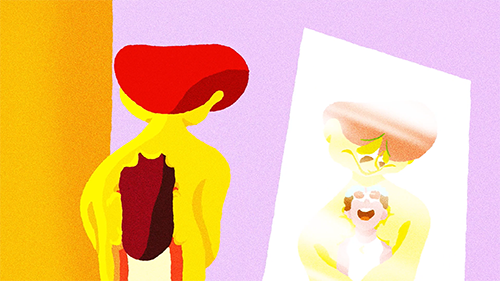
A couple’s love relationship ebbs and flows through pure joy and disturbingly dark episodes in this animated tour de force.
In the forest, a young man rescues a young girl from a rampaging boar. For him, it’s love at first sight. He envelops her into the human-shaped hole in his own body and they literally become inseparable as they float through a candy-colored, funky world of romantic joy. He wakes up from his reverie and discovers she’s gone, leading the boy on a dark, desperate quest to find her. She returns in a different form and he immediately imprisons her in his body-hole, but she breaks free again. He transforms into an ashen, crumbling figure as his rage grows. How could she dare to leave him? He brutally stitches her into his own body, where she becomes his prisoner. The reappearing butterfly representing her freedom leads the deformed pair to the moonlit treetops, where shocking fates befall them both.
■Love is a selfish emotion in the world of XU Yuan’s 8-minute animated epic. This organically animated film is in a constant, stunning flow-state while SATO Nanami’s diverse music perfectly complements the ever-transforming nature of the couple’s relationship.
The Story of My Meat Lifeby ISHIKAWA Mai (5 min.)『肉にまつわる日常の話』
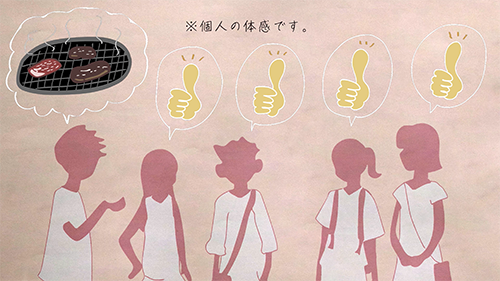
In this energetically animated short, a young woman examines her lifelong dislike of meat while not strictly following a vegetarian or vegan lifestyle.
In Japan, yakiniku is the meal of choice for gathering friends whatever the occasion, states the narrator over animated sizzling chunks of meat. There’s only one problem –– she hates meat. Back in her childhood, she saw an animal-themed movie (cue cute pigs made of paper) and found out the truth of where our pork comes from. She felt guilty about throwing away so many meat-filled school lunches (the screen fills with meaty illustrations) but eventually discovered delicious alternatives, including a particular shrimp-flavored soup she would hunt down at convenience stores. Now, she carefully inspects the ingredients of all the products she buys, checking for the dreaded kanji for meat (which fills the screen). She’s not vegan or vegetarian –– she’s just not a fan of meat, and enjoys cooking with non-meat ingredients. She wonders if all of these positive lifestyle changes would’ve happened if it weren’t for that one movie...
■Director ISHIKAWA Mai, who also narrates, takes a multi-media approach to her topic, blending stop-motion origami, animation-filtered footage, and handwritten text. The film also makes a strong case for the influence one movie can have on someone’s life.
(in order of film length)
See You Next Week... by HYNES Mariko (36 min.) 『また来週』

The life of a girl in high school begins to mirror the lead character in the morning TV drama she’s obsessed with.
In post-WWII Japan, a young girl (MORIKAWA Chihiro) tells her conservative parents she wants to go to Osaka to fulfill her dream of becoming an actress. We realize it’s a morning TV drama playing out, watched by high school student Asako (also played by MORIKAWA Chihiro). Asako’s morning TV ritual makes her late for school every day, angering her home room teacher and exasperating her hard-working single mother. Her guidance counselor is sympathetic, and Asako confides in her that she has similar aspirations of becoming an actress. Asako also develops a friendship with her cultured classmate Yuka, who plays the violin beautifully. Asako’s other classmates are not so kind, laughing at Asako for the similarity of her plight to the drama’s protagonist. All of the characters gradually spill over into both worlds, with fiction and reality seemingly influencing each other as they converge. How will the story end for both Asakos?
■Director HYNES Mariko perfectly captures the tone and style of Japan’s beloved NHK morning dramas and intercuts fiction and reality until they blend seamlessly. This entertaining film brimming with creativity is also a sharp commentary on the ideals fiction can drive us to live up to.
Half Timeby Zhang Yaoyuan (30 min.)『ハーフタイム』

A Chinese laborer working in Japan tries his best to play by the rules to support his family back home, but faces adversity at every turn.
Japan-based Chinese laborer Qingyang struggles to explain himself in Japanese at his latest job interview, but fails. He’s then berated by his local Chinese employment coordinator. This only adds to his hardship of unpaid wages due to his previous vegetable factory’s closure in Okinawa. He drinks with his dorm mate, who decides to go on the run and find work illegally. “If you want money, forget about saving face,” he says. While Qingyang is desperate to support his wife and son back home, he doesn’t want to break the rules as a visa overstayer. Unfortunately, his colleague’s actions affect his situation negatively and his wife threatens to leave him. A non-profit labor lawyer convinces Qingyang to trust his efforts to protect his rights. Qingyang steels himself for another interview, but there’s a shocking turn of events...
■Director ZHANG Yaoyuan depicts the plight of Japan-based laborers who hail from his own region of Northeastern China, which many fled due to the government’s retrenchment policies. In its 34 minutes, the film captures the raw reality of the exploitation many Asian laborers face under Japan’s technical intern training program, sometimes at the hands of their own compatriots.
On a Long Summer Dayby Liu Ge (28 min.) 『ただいまはいまだ』

Two Chinese residents living in Japan reunite during the border restrictions of the pandemic and bond over their life decisions with a Japanese friend.
Chinese exchange student Li visits his buddy Taro in the suburbs to find the apartment of estranged childhood friend Gao (Li’s and Gao’s fathers are old friends). Gao’s not home but contacts Li soon after and meets them at the park. Li implores Gao to call his father in China, but Gao refuses to leave Japan as he wouldn’t be able to return under the current pandemic border conditions. Li feels no stress over staying put –– he enjoys Tokyo. When Taro invites them over for dinner, Gao initially refuses but later joins. Along with Taro’s sister Asuka, the four bond over talking about their lives and complicated paternal relationships. Taro reveals he failed to become a pro boxer like his dad. After dinner and drinks, Taro gets the old boxing gear out and both Gao and Li try punching for the first time. It becomes a release. The morning after, personal decisions are made.
■Director LIU Ge portrays friendship between Japanese and non-Japanese residents in a refreshingly matter-of-fact way, without platitudes or grand statements on differences. He draws naturalistic performances from his cast and accomplishes layered storytelling that belies the film’s running time. A lightning-backed conversation on the balcony is impressive.
Flip-Up Tonicby WAKUI Ryo (26 min.)『Flip-Up Tonic』

A university student applies for a trial session with a humanoid robot developed on campus and becomes shocked when it goes missing.
First year university student Tarano signs up for a paid session where he will experience time spent in the company of a humanoid robot developed in the science department. After signing a non-disclosure agreement and handing over his smart phone, Tarano, the android’s creator Dr. Sinntow, and the android, which goes by the moniker of LEACHAR (“Laboratory Engineered Astonishingly Capable Human Android Robot”) head to a local café for a chat. Tarano is stunned by the perfectly lifelike appearance of the robot. After a slip-up with a glass of water forces Tarano to change shirts, he’s shocked to find LEACHAR has left the scene and heads back to the campus with Sinntow. He’s paid his participation fee and is none the wiser to the surprising truth of the experiment...
■With its crisp black-and-white photography and non-linear storytelling, director WAKUI Ryo aimed to pay homage to both classic cinema and famous movies with time-jumping narratives. The order the chapters play out creates tension, embellished by a clever twist.
Sad Colorby TAKAHASHI Eiichi (24 min.)『サッドカラー』

When a woman is diagnosed as lacking the ability to feel sadness, her husband confines her to their apartment until she recovers, but the situation devolves into madness.
Matome is unsettled by his wife Mia’s recently happy state. He urges her to get examined by a medical specialist, who analyzes Mia’s tears and determines that she’s unable to feel the emotion of sadness. She denies the result, but her husband is shattered by the truth. Believing that a human missing this emotion is a danger to others, Matome confines Mia to their apartment and attempts help her recover with peculiar notions of things that make people sad (such as having to eat a slice of burnt toast). After Mia’s initial anger passes, she begins to question whether sadness is a necessary emotion at all. In a last bid effort to force Mia’s sadness to return Matome makes the ultimate sacrifice, but how will it affect Mia’s existence?
■Influenced by the writings of philosopher Benedictus de Spinoza, filmmaker TAKAHASHI Eiichi skillfully employs geometric framing and chiaroscuro lighting to depict a semi-dystopian world where emotions can be scientifically analyzed with mathematical precision.
Time of Absence by KAWAGUCHI Junya (21 min.)『不在の出来事』

A man carries out his daily chores before leaving the house, after which the space seems to come alive with a little help from nature.
A young man living alone wakes up and goes about his daily routine. He gets dressed, hangs the laundry out on the veranda, and washes up the sink full of dishes. He gets a call from his girlfriend and agrees to meet up. After he leaves the apartment, nature takes over. With charming piano accompaniment, the wind choreographs a beautiful dance performed by the curtains, the socks hanging outside, and stray tufts of cotton. Scattered shopping receipts traverse the floor like migrating fish. Doors open and close by invisible hands. Rivulets of water drizzle down fixtures like natural springs. Condensation forms on a wall like a forehead perspiring on a hot summer day. Even the setting sun is alive within the door’s peephole, until...
■Director KAWAGUCHI Junya (who also shoots, edits, and stars in the film) turns an average Tokyo apartment into a stage for nature to put on a spectacular show. The director has a keen eye for beautiful details that most of us overlook in our busy lives.
Chotto Hakuneby OHNO Senari (20 min.)『ちょっと吐くね』

Two young women at university bond over their psychological need to secretly throw up, and learn about themselves in the process.
At the university dining hall, Yuzusa asks her boyfriend for a bite of curry but immediately goes to throw up. She has been hiding her eating disorder. On another day at the same toilet, Yuzusa overhears a girl vomiting in the adjacent stall and asks if she’s okay. Art student Shizuha is also afflicted and the pair strike up an anonymous relationship over the partition in the little-used washroom, agreeing to meet regularly. Yuzusa confesses that she wants to become as cute as Elsa Schiaparelli’s “shocking pink,” while Shizuha is relieved that someone like Yuzusa also pukes. In the meantime, Yuzusa’s boyfriend struggles to accept her eating habits and disagrees that it will help her overcome her self image issues. After the pair of girls finally come face to face, they realize their feelings about throwing up differ...
■Director OHNO Senari discovered a considerable number of her friends had experienced eating disorders, and conceived of this film as a way to work through her feelings of undue attention and evaluation toward her own abnormalities. The constructed set of the two toilet stalls and metaphorical visual of paint-pouring artwork are astute creative choices.
Kokorozashi to Tokyo by SUZUKI Rintaro (10 min.) 『こころざしと東京の街』

The day arrives for two high school classmates to declare their future plans. One of them has precise goals while the other is undecided. When the chance to have some innocent fun arises, they reach a crossroads.
Sato and Kanemoto are two second-year high school classmates coming to the end of their third term, and today is the deadline to submit their career aspiration surveys. Kanemoto is ahead of the game, with a highly practical approach to his university and career pursuits. Sato is the opposite – ambivalent about what direction he wants to take in life. He asks Kanemoto to wait for him so they can leave together. By the end of the school day, Sato fortunately receives a one-day extension to research his options and make his final submission. On the walk home with Kanemoto, they run into two other classmates who invite them out to a bout of karaoke. Kanemoto remains diligent about his studies while Sato gives in to temptation, despite Kanemoto’s muted disappointment. Along the way Sato changes his mind, but is it too late?
■Director SUZUKI Rintaro skillfully uses mundane locations – desks, residential streets, and train platforms – as a microcosm to stage the paths, diversions, and disorientation in the two boys’ lives.
Parking Area by MASUYAMA Toru (9 min.)『Parking Area』

A woman stops at a highway rest area and enters a portal to another world, before getting back on the road to an even more epic destination.
A Mazda travels smoothly along the highway. We float inside the car through the rear window and find a woman asleep in the seemingly self-driving vehicle. She awakens and we are briefly inside the world of her eye. At dusk, she stops at a highway rest area and uses a massive restroom with infinite sinks to wash her hands. She explores the structure and crosses a walkway into a futuristic urban landscape. Building surfaces shimmer and coruscate organically. Solar panels fan open and recede like flower petals. Freeways spiral into the sky, forming geometric patterns that recall natural wonders. But there are no other humans to be seen. She returns to the rest area, and back onto the highway. After her car emerges from a tunnel, it goes on a spectacular celestial journey.
■Director MASAYAMA Toru defies the low budgets that restrict a lot of live action filmmakers and creates stunning worlds completely created on his iPhone and MacBook Pro. Inspired by an incident on one of the director’s road trips back to his own home town.
『Sewing Love』by Xu Yuan (8 min.)『Sewing Love』

A couple’s love relationship ebbs and flows through pure joy and disturbingly dark episodes in this animated tour de force.
In the forest, a young man rescues a young girl from a rampaging boar. For him, it’s love at first sight. He envelops her into the human-shaped hole in his own body and they literally become inseparable as they float through a candy-colored, funky world of romantic joy. He wakes up from his reverie and discovers she’s gone, leading the boy on a dark, desperate quest to find her. She returns in a different form and he immediately imprisons her in his body-hole, but she breaks free again. He transforms into an ashen, crumbling figure as his rage grows. How could she dare to leave him? He brutally stitches her into his own body, where she becomes his prisoner. The reappearing butterfly representing her freedom leads the deformed pair to the moonlit treetops, where shocking fates befall them both.
■Love is a selfish emotion in the world of XU Yuan’s 8-minute animated epic. This organically animated film is in a constant, stunning flow-state while SATO Nanami’s diverse music perfectly complements the ever-transforming nature of the couple’s relationship.
The Story of My Meat Lifeby ISHIKAWA Mai (5 min.)『肉にまつわる日常の話』

In this energetically animated short, a young woman examines her lifelong dislike of meat while not strictly following a vegetarian or vegan lifestyle.
In Japan, yakiniku is the meal of choice for gathering friends whatever the occasion, states the narrator over animated sizzling chunks of meat. There’s only one problem –– she hates meat. Back in her childhood, she saw an animal-themed movie (cue cute pigs made of paper) and found out the truth of where our pork comes from. She felt guilty about throwing away so many meat-filled school lunches (the screen fills with meaty illustrations) but eventually discovered delicious alternatives, including a particular shrimp-flavored soup she would hunt down at convenience stores. Now, she carefully inspects the ingredients of all the products she buys, checking for the dreaded kanji for meat (which fills the screen). She’s not vegan or vegetarian –– she’s just not a fan of meat, and enjoys cooking with non-meat ingredients. She wonders if all of these positive lifestyle changes would’ve happened if it weren’t for that one movie...
■Director ISHIKAWA Mai, who also narrates, takes a multi-media approach to her topic, blending stop-motion origami, animation-filtered footage, and handwritten text. The film also makes a strong case for the influence one movie can have on someone’s life.
